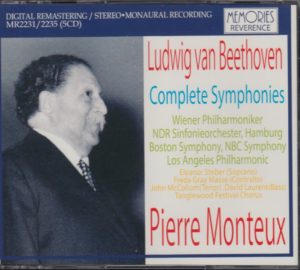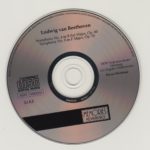
This morning, under mostly cloudy skies and a temperature of just 56 degrees F., I’m glad to be inside, in another of my Happy Places: a Chick-fil-A restaurnt.
But I’m not alone.
I have my ninja to keep me company. I like to think he’s a friend. But he’s a ninja. So, like our cat, Larry, who will turn on me in the blink of an eye, I have to watch my ninja like a hawk.
If I don’t he’ll eat my bagel.

As I’m siting here – keeping watch on my ninja – I’m listening to French/American conductor Pierre Monteux (1875-1964), the NDR Sinfonieorchester Hamburg, and Beethoven’s Symphony No. 4 in B flat Major. This recording is older than I am.
Speaking of old, I believe Maestro Monteux is the oldest conductor to whom I’m listening in my Beethoven project. Born in 1875, he didn’t see the dawn of the last century for 25 years after his birth. Twenty-five years!
 Monteux lead a long and noteworthy life (even though most of his recorded music seems to be lost or in vaults somewhere), perhaps culminating in what would becomes his legacy: the Monteux School and Music Festival in Maine (United States).
Monteux lead a long and noteworthy life (even though most of his recorded music seems to be lost or in vaults somewhere), perhaps culminating in what would becomes his legacy: the Monteux School and Music Festival in Maine (United States).
Prior to my Beethoven project, I had never heard of Pierre Monteux.
Since then, I have encountered his work three other times, on…
Day 14. Rating: “Huzzah!”
Day 32. Rating: “Meh!”
Day 50. Rating: “Meh!”
What will today bring?
I will soon find out.
 Beethoven wrote his symphonies in four parts (except for the Sixth, which is in five). The time breakdown of this particular one (Symphony No. 4 in B flat Major), from this particular conductor (Monteux, at age 84) and this particular orchestra (Boston Symphony Orchestra), at this particular time in history (1959) on this particular record label (Memories Reverence) is as follows:
Beethoven wrote his symphonies in four parts (except for the Sixth, which is in five). The time breakdown of this particular one (Symphony No. 4 in B flat Major), from this particular conductor (Monteux, at age 84) and this particular orchestra (Boston Symphony Orchestra), at this particular time in history (1959) on this particular record label (Memories Reverence) is as follows:
I. Adagio – Allegro vivace……………………………………………………………….10:27
II. Adagio………………………………………………………………………………………..9:06
III. Allegro molto e vivace – Trio. Un poco meno allegro………………..5:49
IV. Allegro ma non troppo………………………………………………………………..5:26
Total running time: 30:08
My Rating:
Recording quality: 4 (a disconcerting 11-second lead-in to the music in Movement I, considerable tape hiss, but otherwise a very crisp, clear recording)
Overall musicianship: 5
CD liner notes: 0 (no liner notes – boo! hiss!)
How does this make me feel: 5
“Huzzah!”
I was worried at first when it took 11 seconds to get to the music in the first movement. Then, when the audio did start, it sounded like rainfall: tape hissy.
But then the performance began and, wow, I was blown away.
This is an extremely tight, crisp, dynamic, energetic performance. There’s no lack of treble (which is common when noise reduction is applied to a recording).
It feels alive.
I listened to this performance 3-4 times through, each time enjoying it more, hearing new things with each listen.
Monteux even made the Adagio (Movement II) came alive. The pizzicato was fun. And I was engaged with every note and instrument.
This is an old recording, and I can excuse the tape hiss – especially when the performance is so good. What I can’t excuse is a lack of liner notes. There’s nothing in this CD set that indicates who Pierre Monteux was, and no technical or narrative notes. When and why were these performances recorded? Are they considered Monteux’s best? Why were these compiled?
From my days as a Marketing guru and adjunct university professor, I used to drill into my students the phrase WIIFM (“wiffum,” as it’s pronounced all run together). It stands for What’s In It For Me? In short, a savvy marketer will always assume the position of the customer who is always asking “What’s in it for me?”
There’s no WIIFM with this box set, no reason why I or anyone else should buy it.
Which is a shame because there are some splendid performances here from a director largely forgotten.
I heartily recommend today’s recording.
“Huzzah!”
